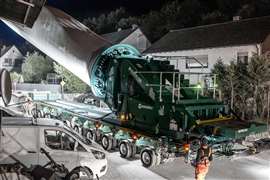SC&RA Comment: Security Concerns For Wearable Tech
02 August 2019
The construction and transport industries, while playing catch up fairly well in recent years, are still behind the curve in many ways as it applies to cybersecurity. To that end, we hear more and more about wearables – smart electronic devices that can be incorporated into clothing or worn on the body as implants or accessories.

Wearable technology has a variety of applications, which grows as the field itself expands. It appears prominently in consumer electronics, with the popularization of the smartwatch and activity tracker. Apart from commercial uses, wearable tech is being incorporated into navigation systems, advanced textiles and healthcare.
Wearable technology for the construction industry
For the constrction and transport industries, wearables monitor heart rates and fatigue, track worker or equipment location and even detect accidents. But in the age of cloud and connected platforms, securing privileged and confidential information has become a challenge for contractors – and these types of wearables have added another layer of concern as to whether the information these tools collect is as safe as it could be.
Wearable devices such as activity trackers are an example of the Internet of Things (IoT) – with “things” like electronics, software, sensors and connectivity as effectors that enable objects to exchange data through the Internet with a manufacturer, operator and/or other connected devices, without requiring human intervention. However, no standards are in place to govern how data gleaned from wearables is used and protected.
As you might imagine, quite a few questions surround such a concern – especially for industries like construction and transport, who are relatively new to the technology.
Addressing cybersecurity concerns connected to wearables
The International Safety Equipment Association (ISEA) plans to start discussing the development of privacy and use standards – if not at least some type of guidance – at its next annual meeting in November. The discussions will focus on data collected from wearables, how workers can view this information and in what ways the data can be analyzed to predict trends and patterns so as to better assist workers.
Since workers across a variety of industries are already reluctant to embrace wearables – or other types of IoT technology that is deemed invasive – this ISEA discussion couldn’t be happening at a better time. Many industry insiders feel that innovative solutions will not only address well-needed cybersecurity concerns connected to wearables, but alleviate some of the many aversions workers have to participating in the technologies.
Matthew Ramage, business area director at Trimble, recently said, “The simple way to do this is to either offer visibility of the improvements from collation of this data via digital signage – or reporting on things like reduction in dangerous incidents – or offer each employee details of what, why and how data is going to be collected and used prior to implementation.”
Reduce the risk of wearables and IoT in your company
In the meantime, some risks to definitely keep an eye out for if you, or your company, has entered the wearables/IoT era:
- Low-power devices without sufficient processing capacity for security controls
- Cheap, unsupported devices with a “set-it-and-forget-it” mentality – usually produced by companies without security skills
- Devices without adequate manual backups/overrides available, such as emergency power off or fallback to “non-connected” controls
- A lack of policy and process designed to address and manage the installation and operation of said devices within your company.
The benefits of IoT
Some might ask, why are we using these devices if there’s so much risk associated with them?
Because, from a business’ standpoint, IoT and wearable sensors are a vital source of information in the knowledge economy, and they can offer significant cost savings (a camera can monitor and alert on activity 24/7 for a fixed cost, while a human guard would be exponentially more expensive). Employees and consumers find these devices valuable for many of the same reasons: for relatively little cost, we can get lower energy bills, safer and more efficient operational practices or better health outcomes.
STAY CONNECTED


Receive the information you need when you need it through our world-leading magazines, newsletters and daily briefings.
CONNECT WITH THE TEAM










